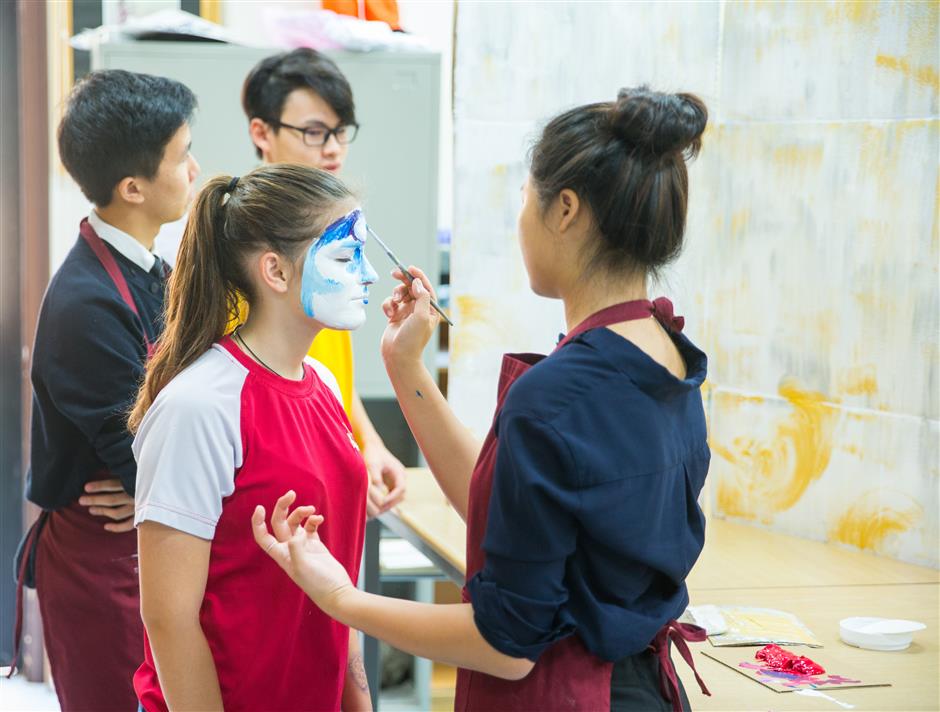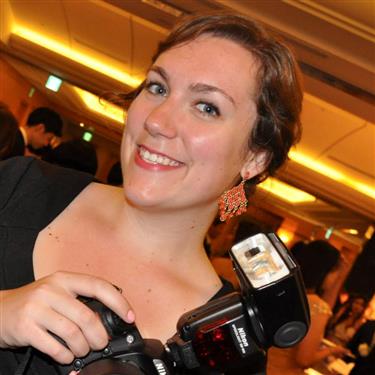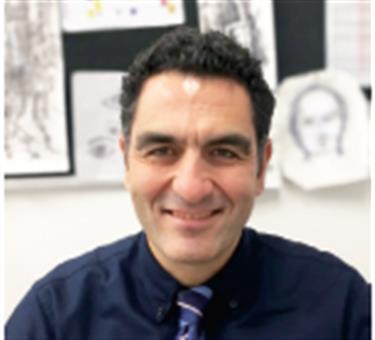Arts in classroom builds personality

The students at Dulwich College Shanghai Pudong learn face-painting on the class.
International schools are integrating art in their syllabus with students creating artworks using keyboards and trackpads. They benefit by developing skills, training their fingers and creating new mental pathways.

Cara Slabaugh Whiteside is Design and Visual Arts teacher at SCIS.
Arts imperative to build strong educational foundation
Arts in education — seems an easy enough conversation to have. Study after study has proven that involvement in dance, drama, visual art or music dramatically raises reading, writing and math scores. Visual literacy has repeatedly been connected to language acquisition and development. There are even in-depth studies that go into how focused practice within the arts physically re-wires the brain in beneficial ways. With all of these studies coming back in a resounding affirmative, why is this still such a controversial subject within an educational context?
The sad reality is that there are schools, administrators and parents that still do not believe that the arts will do anything but distract their students from what is important. However, for international students, the arts are imperative to building strong educational foundation.
Here in Shanghai, I have the opportunity to teach students from across the globe. My students come into class with vastly differing world outlooks, languages and life experiences. When students are first acclimating to a new school community and language, the arts classes are often where they are able to succeed first. In visual arts, for instance, not only do students learn the technical skills for art making, but they learn how to see and understand in a visual language. They are able to see and build connections to other students’ experiences, to their other classes, and to the world around them.
I am privileged to work at a school that fully values the arts. At Shanghai Community International School, we have fully adopted the International Baccalaureate continuum for all students from nursery to Grade 12. In the Middle Years Program and Diploma Program, the arts have equal time and importance as core subjects like math, science and English. Many of our middle and high school students are able to take multiple arts subjects, and in many cases, are encouraged to do so. This attitude, presented through the curriculum reinforces to parents and students the value of the arts in their learning as a whole. Students know and understand how they can take what they are learning in the arts and apply it to other subjects. These connections support their learning in all subjects making them more prepared to think critically when they leave my care and move forward in their education and their eventual entry into the global workforce.
(The article is contributed by Cara Slabaugh Whiteside.)

Norman Lacey is an art teacher at Harrow International School Shanghai.
Art class helps in linking creativity and invention
The value of art in schools is only too evident, and is one of the few subjects where 21st century thinking is allowed to occur in the classroom, with invention and creativity linked to a task. Art develops minds that can solve a challenging problem, put together a sequence of ideas to form a solution, even creating real links between subjects, with the importance of mathematics and sciences in art, architecture, engineering and design, linking together.
Art is all around us, so are numbers, so is science, and so are words. Often it is through art, and creative manipulation of these subjects that students are drawn into the future, involving them in thinking and doing, making something that is useful, great to look at or just a great process to find out how, what and why.
(The article is contributed by Norman Lacey.)

Rhian Dixon is head of art at BISS Puxi.
Exploring art, design and thinking skills
Art education provides an opportunity to participate in creative activities that will enrich your experience and engagement with the arts.
At BISS Puxi, we explore diverse ways of exploring art, design and thinking skills that challenge our students to be ambitious throughout their learning experience. We offer a rich and varied curriculum both in the classroom and beyond. We collaborate with innovative and prestigious organizations such as MIT (Massachusetts Institute of Technology) and have state-of-the-art STEAM teaching facilities across our primary and secondary campuses. We are currently working as a whole school to embed the philosophy of the “Design Thinking” cycle and project-based learning.
Art is a highly regarded and celebrated subject within our school and the community. In October, 50 of our talented and enthusiastic artists embarked on an exciting two-day art challenge. Our theme for the event was the ocean and the harmful effects that plastic can have on our environment. This links to our global goal of creating “sustainable cities and communities,” supported by the Nord Anglia Global campus. We have a striking display of our magnificent outcomes for our visitors to admire as they enter the secondary building.
In the wider community, we take part in many competitions and charity events. Our students recently spent a day creating designs and glow-in-the-dark paintings inspired by luminescent creatures. Three of our lucky artists were interviewed about their experiences which appeared across social media.
(The article is contributed by Rhian Dixon.)

Jennifer Marsh is an art teacher at Nord Anglia International School Shanghai, Pudong.
Art stimulates brain, encourages students to think openly
ART is extremely important in schools and in our lives. It has been produced since history began. Every part of the world has its own style, color, materials and a never ending, fascinating array of art to be enjoyed and admired.
Humanity has always been drawn and created and we often judge civilizations on their creativity — the ancient Egyptians for example.
The man-made world around us of buildings, cars, clothes, furniture, etc, are all designed and created by individuals who have studied art. The world is full of careers that art and design are based. Medical students in the UK have art included in their training due to the skills it teaches!
Here at Nais Pudong, I have introduced a range of project work to the students beginning in Year 7 through to Year 12 and 13 — IB Visual Art. We look at still life, 3D design and sculpture, graphic design, pattern and print to name but a few.
Observational drawing and the formal elements are all important, as is confidence.
Of course, all students are encouraged to look at other artists, designers, crafts people as well. Art is very personal and individual and takes courage.
The skills, knowledge and understanding that children learn through art and being creative are many. Art teaches children to think openly and encourages a culture of questions. It stimulates both sides of the brain. It teaches that there is more than one solution to a problem.
Art promotes self-esteem and provides a common ground across stereotypes and prejudices. Studies in the United States show that students who make art, read to a higher level and achieve better grades in science and mathematics.
Art encourages children to give more attention to the physical space that surrounds them and develops hand and eye co–ordination. It encourages reflection, decision making and problem solving.
I love art that keeps evolving and changing. The Internet has opened up art to artists and designers and also followers of art. Never a dull moment! Although there is still nothing better than going to an art gallery and experiencing work in the flesh so to speak.
Finally to finish a quote from Picasso: “The purpose of art is washing the dust of daily life off our souls.”
(The article is contributed by Jennifer Marsh.)

Jane Klammer (left) provides feedback to an advanced studio art student on her latest art project.
Art appreciation helps in understanding world
We live in a world that is full of visual images; therefore, we acquire a great deal of information and knowledge about our environment through images rather than merely through text and numbers. Illustrations, graphic images, charts, photography and creative text — all forms of visual art — allow information to be communicated beyond the written word.
Visual arts education vitalizes problem solving and critical thinking skills, enlightening students on how to interpret, critique and use the visual information they encounter to make decisions based on their experiences. It also helps students better understand the past. Historical and significant cultural events recorded in drawings, paintings and sculptures allow us to visually remember the past and record history for future generations. Visiting art museums and art galleries helps spark an appreciation of those artists who have withstood the test of time in their creative endeavors and their use of media.
In the Information Age, more and more students are creating artworks using keyboards and trackpads. Students benefit from developing new skills, training their fingers and creating new mental pathways. However, as art educators, we should not overlook the visual-spatial skills that students acquire in a traditional art class. Elemental exercises like gripping a paintbrush, holding a pencil, smudging charcoal, scribbling with chalk or crayon or squeezing clay are activities for improving fine motor skills and keeping them.
Drawing, painting and sculpting also provide students the opportunity to take a break from time in front of computer screens and engage in the pleasure of creating, allowing the right side of their brains to experience the joy, contentment, timeliness that comes with making art.
Learning is not limited to the information we acquire; it is dependent on how we receive information and how we interpret that information collectively, imaginatively, and meaningfully. An appreciation and understanding of art allows students to better understand the world, and it is an essential component of a holistic education.
(The article is contributed by Jane Klammer, a high school visual art teacher at Concordia International School Shanghai.)
Art plays a role in balancing lives
Over the past decade many of us have heard the mantra “students of today will be doing jobs which haven’t been invented yet.” Google it and a plethora of studies will be revealed, placing the statistic at anywhere between 50 and 85 percent. If we believe it to be true, and at Dulwich College Shanghai we do, it is clear that the skill sets required by today’s students are changing rapidly. We anticipate that the ability and flexibility to gain and use new understanding will be valued above knowledge itself.
A well delivered art education is hugely important in preparing students for the future. Within the studio students have the opportunity for “hands on” learning whether with traditional materials or new technologies. The act of acquiring art and design skills is in itself a problem solving activity with the road to mastery requiring practice and reflection. The act of applying those skills in own work ensures that students are thinking independently, thinking laterally, thinking creatively, and are rewarded with a tangible outcome in which they can take pride.
ithin the context of an international community we are sensitive to the importance of giving students the chance to explore their personal and cultural identities as well as experience those of others. We ensure that our curriculum is broad and varied, encompassing world art history as well as contemporary art and ensuring exploration of a broad range of art, craft and design skills. Alongside tuition in practical skills and the opportunity to experiment with materials, students are guided to present a personal and thoughtful response. This firm focus on process as well as outcome means our art students build a positive attitude to learning and regularly practice the skills that will serve them through their adulthood including organization, communication, motivation, reflection and interpersonal skills.
We know that humans have instinctively made “art” for millennia, with painting and drawing not just pre-dating but contributing to the development of written scripts. Any academic setting places emphasis on literacy and this is supported in art through a focus on visual literacy which fosters in our learners the confidence to decode and make sense of the overwhelmingly visual word in which we live. Sensitivity to symbolism, nuance and established visual conventions, as well as a sense of audience, cultivates perceptive critique of the information, both visual and verbal, they encounter daily. The immersive nature of the arts promotes the sustained focus colloquially referred to as “flow” and promotes wellbeing, positive emotions and balance. We hope that our students take this experience with them, whether or not they pursue study within the arts, continue to lead balanced lives in which the arts play a role.
(The article is contributed by Laura Thomson, head of Visual Arts and Graphic Design at Dulwich College Shanghai Pudong.)

Daryl Bates is Visual Arts coordinator and teacher at SSIS.
Art connects concepts, themes explored through experience
“The arts matter because art is meant to move people either on an intellectual or emotional level. Whether this is a book that stays with you days later, or a performance that moves you spiritually or a song that makes you look at the world around you in a different way. The purpose of art is to cause a reaction and with this purpose it can create a synergy of change; change in attitudes, perceptions, and thoughts.” — Catherine Brookes
Art is like no other subject students will undertake in their studies, as it links to all other academic subjects, presenting a back door into learning in those domains. Art is essentially skill based in most curriculum, yet it can connect concepts and themes explored through the lived experience of each individual student. Education scholarship is finding that the more arts student has in their academia, the better they perform across their subjects and socially. In a related study, Dr James Cantrell of University of California, Los Angeles, reports, “Academic grades, standardized test scores, measured reading levels and attitudes concerning commitment to community were all higher for students maintaining high levels of activity in music, chorus, drama and the visual arts.” This study of over 25,000 students’ responses to art in their curriculum points to a need for schools to look carefully at how balanced the contact time within the art lesson they provide their students.
In a meta-analysis report published for the National Endowment for the Arts by Sandra S. Ruppert, the arts were found to provide six significant benefits in child development: reading and language skills, mathematics skills, thinking skills, social skills, motivation to learn and positive school environment. Art is the intuitive, imaginative, emotive and cognitive innate life skill that all people possess. Art provides a means to empathize, communicate and understand our world, its social structures, its cultures, individuals and interdisciplinary concepts. Art domesticates complex and controversial topics and situations, through its unique language of image, symbol and semantics.
For students who aspire for careers in design such as architecture, interior design, environmental design, graphic design, marketing, fashion or industrial design, the visual art course is a good path. For students with other interests, the visual arts class offers them social and emotional development, and strategies for approaching real life challenges from alternative perspectives.
Culture, history, communication and aesthetics share space within the core of the subject. Students enjoy the course for many reasons, among them, hands-on problem solving, imagination stimulation and play, functional design and entertainment as learning. At once a course of utilitarian value, the mimesis of artistic practices researched and observed provoke cognitive challenges through thought and meditation. With a vocabulary of its own, visual art intellectualizes students in ways that serve every other course of study they undertake. For the approachable rigor the visual arts command, we remind the students they are more than creators, more than artists, they are aesthetic engineers.
(The article is contributed by Daryl Bates.)

Emre Ozkurt is an art teacher at YCIS Shanghai Gubei campus.
5 creative ways to kick-start interest in art in your child
AS parents, we know we should foster our children’s creativity, but if we don’t feel very artistic ourselves, it can be difficult to support them. Creative expression is essential for social and emotional intelligence and lends itself to stronger science and math skills, so knowing more about how you can help your child develop is essential. Here are some ways you can get their creative juices flowing:
1. Introduce art to your child
Introducing your child to as much art as possible allows them to find the type of art in which they are most interested. That doesn’t have to mean taking expensive trips. Shanghai has a great number of fantastic art galleries and museums, or you can simply provide your child with books on art, or view art together on an iPad.
2. Start with the digital medium
One of the easiest ways to kick-start a young child’s creative side is to introduce them to pop art pieces like Andy Warhol. Often, it’s what children are most attracted to at the beginning of their artistic journey, and it’s easy for them to recreate. You can even use an iPad to make creative pop art together. Later, you can introduce different media, such as crayons and pencils. Next, let them create little comic books, and then have them move on to making collages. These are all excellent ways to encourage them to express themselves and learn what they love to create.
3. Allow them to get messy
Often, parents hesitate to allow their child to create a mess, but for them to truly express themselves, you need to let your child be free and creative. Let them be messy as long as they are creating something. Find a space in your home where they can let their creative side out. If you want to have an easy cleanup solution, you can get a large piece of plastic laid out on the floor or table, and by giving them a creative space, you’ll see their art flow!
4. Start a dialogue with your child about art
Ask your child questions and start a dialogue about art. You also shouldn’t feel like your child has to like every art piece. If you’re in a gallery and your child doesn’t like a piece of artwork, ask them, “Why don’t you like it?” Encourage them to become little art critics! By doing this, they begin to hone in on details and techniques that they might try themselves.
5. Look for messages in your child’s artwork
When your child brings something home from art class, it’s important to talk about the artwork instead of blindly praising it. There’s always a message in the art which gives a window into what’s happening in your child’s head. Ask questions about their work, such as, “Tell me about what’s happening in your picture,” or “How did you come up with that idea?” It’s a fantastic way to not only learn more about what your child is thinking but also show that you’re truly interested in their expression and support their creativity.
Toward the end of his life, Pablo Picasso visited an elementary school and was in awe of the art the children had created.
He said, “It took me four years to paint like Raphael, but a lifetime to paint like a child.” As parents, we need to embrace our children’s creative expression and help them thrive during this critical point in their development.
(The article is contributed by Emre Ozkurt.)















